Welcome to Buenos Aires, a city where every sip tells a story and weaves a vibrant tapestry of culture and history. This metropolis is not only the heart of Argentina, it’s also a melting pot where European sophistication meets indigenous spirit. Here at ExpatPathways, we’ll guide you through the city’s vibrant drinking scene, designed for expats, digital nomads and travellers who want to savour authentic local experiences.
Our journey dives deep into the essence of Buenos Aires’ traditional drinks, from the world-renowned Malbec wines to the emblematic Fernet with Coca, which celebrates Argentine camaraderie. Our aim is not only to find the best places to enjoy these libations, but also to showcase the leading brands and diverse interpretations that illustrate the city’s culinary creativity.
Are you ready to indulge your senses and navigate Buenos Aires like a true local? With ExpatPathways as your guide, we’ll unlock the secrets behind the city’s legendary drinks. Take this opportunity to deepen your understanding of Buenos Aires’ rich cultural mosaic, one flavourful sip at a time. Read on and embark on an exquisite adventure that promises more than a taste, but a deeper connection to the vibrant Argentine capital.
Traditional drinks from Buenos Aires
1. Mate
Mate, the quintessential Argentine drink, is more than just a beverage; it’s a symbol of friendship and social gatherings. Renowned brands like Taragüi, Rosamonte, and Cruz de Malta lead the market, offering varieties from “con palo” (with stems) to “sin palo” (without stems), and even flavored versions like orange or herbs-infused mate.
The ritual of sharing a mate, passing it from hand to hand, is a heartfelt tradition seen across Buenos Aires’ parks and public spaces. For those looking to dive into the mate culture, visiting a “bar de mate” or local markets can provide an authentic experience, where you can savor the earthy flavors and perhaps, make new friends.
| Yerba Mate Brand | Why We Think You’ll Like It | Brand Varieties to Choose From |
|---|---|---|
| Playadito | Known for its smooth and light flavor, originating from Corrientes, Argentina. | – Yerba Playadito Con Palo – Yerba Playadito Sin Palo – Yerba Playadito con Hierbas – Yerba Playadito Tereré – Yerba Liebig Original – Yerba Yemaype |
| Cachamate | Offers a smooth, fresh taste with a pleasant flavor profile from Santa Fe. | – Yerba Cachamate Tradicional – Flavored varieties (Coco, Naranja, etc.) – Yerba Cachamate Siluet Plus – Yerba Cachamate Plus Endulzada – Various herbal blends |
| Taragui | Intense and genuine flavor, offering a classic experience from Corrientes, Argentina. | – Yerba Taragui Con Palo – Yerba Taragui Sin Palo |
| Rosamonte | High caffeine concentration, ideal for work, produced in Misiones. | – Yerba Rosamonte Tradicional – Yerba Rosamonte Suave – Yerba Rosamonte Despalada – Yerba Rosamonte Tereré – Rosamonte Selección Especial |
| CBSé | Known for its fresh flavor, perfect for exploring a variety of flavors. | – Flavors like Jengibre, Guaraná, various fruits – Herbal blends (Hierbas Serranas, Hierbas Cuyanas) – Specialty blends (Endulife, Miel, Etiqueta Negra) |
2. Coffee
The café culture in Buenos Aires is a blend of Italian heritage and local customs, making it a pivotal aspect of city life. From the classic “cortado,” a strong espresso cut with a little milk, to a “café con leche,” half coffee and half milk, the variations cater to all tastes. “Lágrima,” more milk than coffee, is for those who prefer a lighter version.
Cafés like Café Tortoni and Las Violetas offer a nostalgic ambiance to enjoy these drinks, often accompanied by medialunas. The city’s café scene is bustling, with each café offering a unique atmosphere to enjoy this integral part of Buenos Aires’ social fabric.
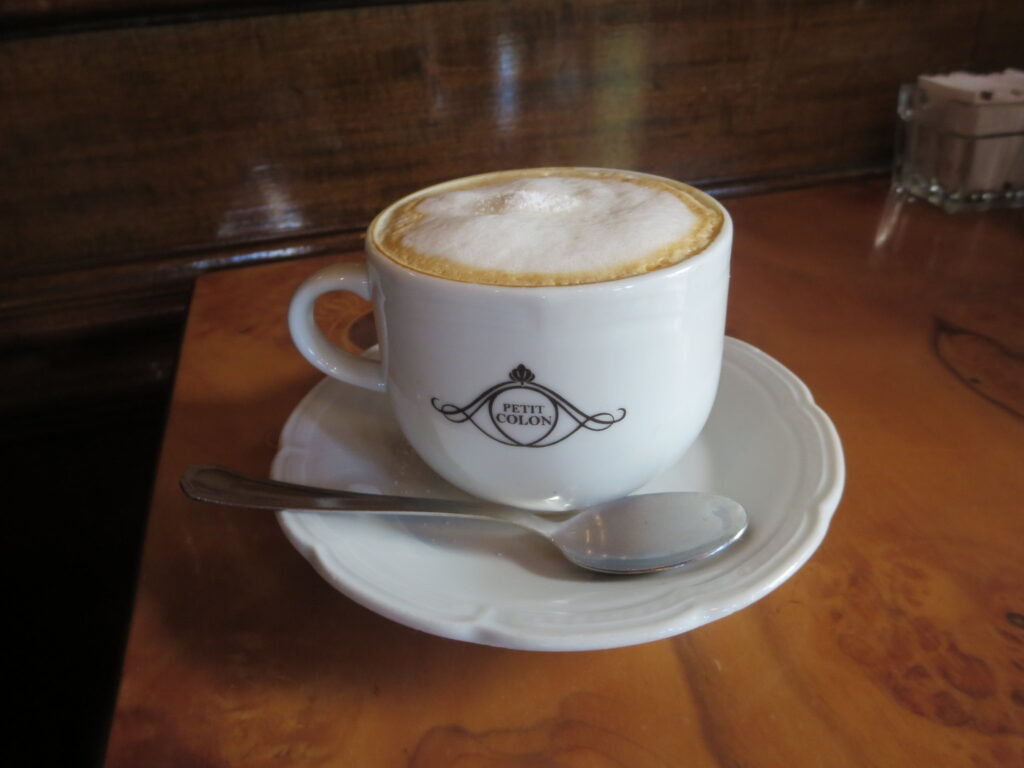
Most notable cafés in Buenos Aires
1. Café Tortoni
Historical Reference: Founded in 1858, Café Tortoni is the oldest coffee shop in the country. Its interior boasts a Belle Époque style, transporting visitors back in time.
Notable Personalities: Jorge Luis Borges, Carlos Gardel, and Federico García Lorca, among others, frequented this café.
For Travelers: Located on Avenida de Mayo, Café Tortoni offers a range of coffee and traditional Argentine pastries. Don’t miss the chance to enjoy a live tango show in the evenings.
2. Las Violetas
Historical Reference: Opening its doors in 1884, Las Violetas is renowned for its stunning stained glass windows and ornate interior.
Notable Personalities: The café has welcomed politicians and intellectuals throughout its history. Its grandiosity makes it a favorite among locals and tourists alike.
For Travelers: Situated in the Almagro neighborhood, it’s the perfect spot for enjoying an opulent afternoon tea or a classic Argentine breakfast.
3. La Biela
Historical Reference: La Biela has been a staple in the Recoleta area for decades, known for its proximity to the famous Recoleta Cemetery.
Notable Personalities: It has been a popular spot for racing car drivers and enthusiasts, as well as international figures like Jorge Luis Borges and Ernesto Sabato.
For Travelers: Enjoy a coffee under the sprawling canopy of the ancient rubber tree that dominates its outdoor seating area, a perfect place for people-watching.
4. El Preferido de Palermo
Historical Reference: Although not as old as some others, having been refurbished and reopened recently, it maintains the spirit of the traditional bodegones of Buenos Aires.
Notable Personalities: A newer addition to the scene, it quickly became a favorite spot for contemporary writers, artists, and musicians.
For Travelers: Located in the trendy Palermo neighborhood, it offers a modern twist on Argentine culinary classics. The pink façade is hard to miss, and the interior decor is equally inviting.
5. Bar El Federal
Historical Reference: Founded in 1864, Bar El Federal is a testimony to the city’s history, with wood-paneled walls and vintage advertisements.
Notable Personalities: Throughout its long history, it has been a gathering place for Buenos Aires’ diverse society, from bohemians to scholars.
For Travelers: Situated in San Telmo, it’s an ideal spot to enjoy a traditional Argentine picada (a platter of assorted appetizers) accompanied by a local wine or beer.
3. Tereré
Tereré, a refreshing twist on traditional mate, is perfect for Buenos Aires’ hot summer days. It’s typically prepared with cold water or juice and yerba mate, offering a revitalizing experience. Combinations can include herbs like mint or citrus flavors, enhancing its refreshing qualities.
Though not as ubiquitous as hot mate, tereré has found its place in the city, especially among younger generations and in neighborhoods with a more alternative vibe. For a genuine tereré experience, head to cultural fairs or markets where artisanal producers showcase their blends and innovations.
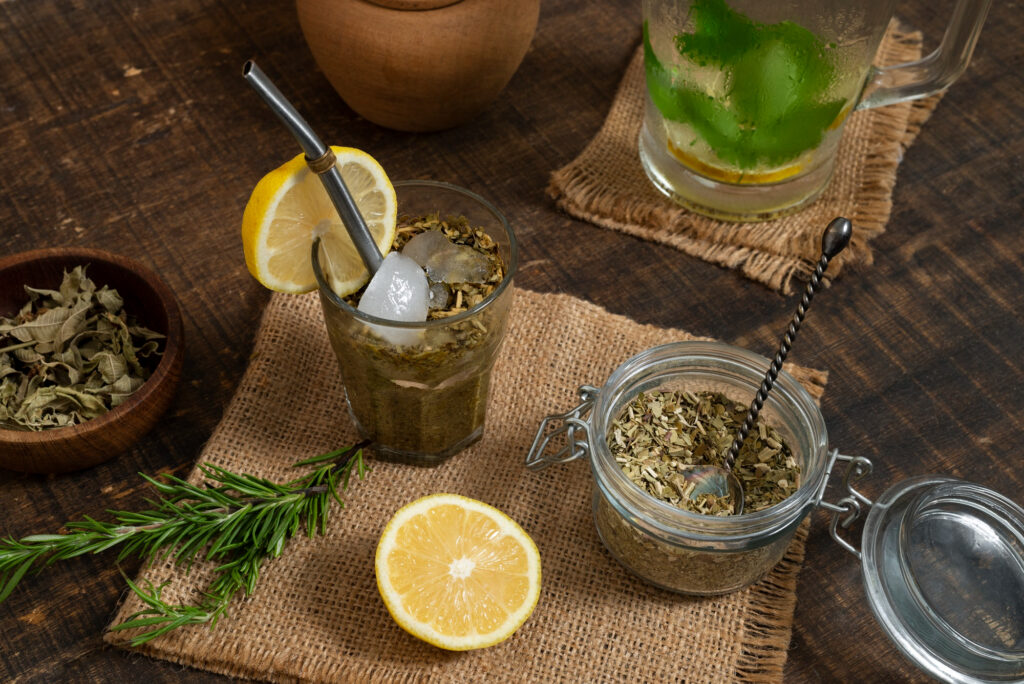
Prepare your own tereré
Ingredients:
- Yerba mate (preferably flavored with a fruity note, such as orange or a mix of citrus)
- Cold water
- Ice cubes
- Slices of lemon, grapefruit, or orange
- A mate cup (also known as a guampa in Paraguay)
- A bombilla (metal straw with a filter at the end)
Step-by-Step Guide:
- Fill the Mate Cup: Start by filling your mate cup (guampa) to about halfway with yerba mate. If you have a fruit-flavored yerba, such as orange or a citrus mix, it will enhance the refreshing taste of your Tereré.
- Mix the Yerba: Cover the top of the mate cup with your hand, turn it upside down, and gently shake it. This step helps mix the finer particles with the larger ones, ensuring an even flavor distribution.
- Prepare Flavored Cold Water: In a pitcher or thermos, prepare cold water flavored with slices of lemon, grapefruit, or orange. Add plenty of ice to keep it chilled. This flavored water will be poured over the yerba to create your Tereré.
- Moisten the Yerba: Pour the flavored cold water generously into the mate cup, soaking all the yerba mate. Allow it to rest for a few minutes. This initial soaking is crucial for activating the flavors of the yerba.
- Insert the Bombilla: Carefully insert the bombilla into the internal side of the mate cup, pressing gently to avoid disturbing the yerba structure too much. This will create a pathway for the water to flow and filter through the yerba without clogging.
- Enjoy Your Tereré: Add a few ice cubes to the mate cup for extra chill. Your Tereré is now ready to enjoy! Continue to add cold water or ice as needed with each refill, sipping directly from the bombilla.
4. Wine
Argentina’s wines, particularly those from the Mendoza, San Juan, and La Rioja regions, have gained international acclaim. Buenos Aires, as a cosmopolitan center, offers a plethora of wine bars and bodegas where enthusiasts can explore varietals such as Malbec, Torrontés, and Cabernet Sauvignon.
From robust reds to refreshing whites and rosés, the city’s sommeliers are keen to introduce patrons to both well-established and boutique labels. Wine tasting events or visiting a “vinoteca” in Palermo or San Telmo districts can provide a deeper understanding and appreciation of Argentina’s rich wine culture.
The 10 types of Argentine wines
1. Malbec
- Profile: Full-bodied red wine with soft tannins and fruity aromas.
- Why Try: Originating from France, Malbec has found its perfect home in Argentina, becoming the country’s wine emblem. Most production is in Mendoza. Best paired with barbecue (asado) or blue cheese.
2. Bonarda
- Profile: Red wine with low tannin content.
- Why Try: The second most planted grape in Argentina, sometimes called the “new” Malbec. It has a dark, intense color and is perfect with meat empanadas.
3. Torrontés
- Profile: Fresh, fruity white wine with low tannins.
- Why Try: The quintessential Argentine white grape, native to the country, primarily grown in the northwest. It pairs well with salty dishes.
4. Cabernet Sauvignon
- Profile: Elegant and subtle red wine with robust and aromatic tannins.
- Why Try: Known as the queen of grapes, this widely adaptable vine produces some of Argentina’s finest wines, especially from western provinces like Mendoza.
5. Merlot
- Profile: Smooth red wine with complex aromatic qualities.
- Why Try: Though not as widely produced, its quality is high, especially from the Uco Valley in Mendoza and Patagonia. Ideal with grilled meat and chimichurri.
6. Pinot Noir
- Profile: Fresh, acidic red wine with earthy aromas.
- Why Try: Requires careful cultivation in cool climates like the Uco Valley, Mendoza, and Patagonia. Great with chicken dishes.
7. Syrah
- Profile: Light, fresh red wine with strong aromas.
- Why Try: Originated in Europe and found a home in San Juan’s Tulum Valley and eastern Mendoza. Pairs well with roasted meats.
8. Tannat
- Profile: Red wine with strong tannins, fruity and full-bodied.
- Why Try: Though more closely associated with Uruguay, Tannat has been gaining ground in Argentina, especially in Salta. Enjoy with marinated vegetables.
9. Chardonnay
- Profile: Fresh white wine with low tannins.
- Why Try: The queen of white grapes, Chardonnay thrives in Argentina, particularly in Mendoza’s temperate zones.
10. Sauvignon Blanc
- Profile: Full-bodied white wine with notable acidity and tropical fruit aromas.
- Why Try: This demanding grape flourishes in Mendoza, offering a refreshing aperitif option.
5. Beer
The craft beer movement has taken Buenos Aires by storm, with microbreweries and beer pubs dotting the city. While international brands are widely available, the spotlight is on local craft beers like Antares, Patagonia, and Berlina, offering styles ranging from IPAs and stouts to Belgian ales.
The neighborhood of Palermo, in particular, is a hotspot for beer enthusiasts, boasting a vibrant scene of craft beer bars where one can explore the creativity and passion of local brewers.
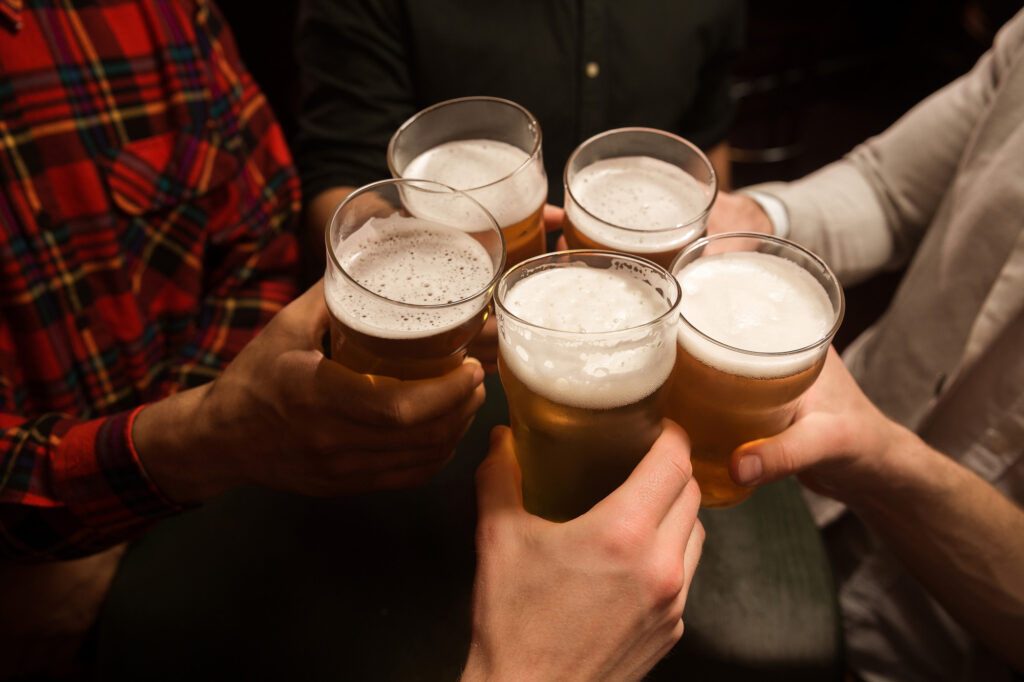
Craft breweries in Buenos Aires
Los Caminantes
- Address: Bulnes 998, C1176, Barrio de Abasto.
- A cozy spot in the historical Abasto neighborhood, perfect for those looking to dive into the local craft beer scene.
Rabieta
- Address: Avenida del Libertador 3949, C1426, Hipódromo Argentino de Palermo.
- Located at the iconic Palermo racetrack, Rabieta offers a unique setting to enjoy artisanal beers with a view.
Bierlife
- Address: Humberto 1° 670, C1103, Barrio de San Telmo.
- Nestled in the heart of San Telmo, Bierlife is ideal for beer enthusiasts looking to combine craft brews with the bohemian vibe of one of Buenos Aires’ oldest neighborhoods.
Blest Palermo
- Address: Gorriti 4857, C1425, Barrio de Palermo.
- A branch of the famed Patagonian brewery, Blest Palermo brings the essence of the south to the bustling streets of Palermo.
Cerveza Patagonia
- Address: Distrito Arcos, Godoy Cruz, C1425 Buenos Aires, Barrio de Palermo.
- This brewery offers a wide selection of beers inspired by the landscapes and flavors of Patagonia, set in a trendy outdoor shopping complex.
Baum
- Address: José A. Cabrera 4427, C1414, Barrio de Palermo Soho.
- Baum stands out for its variety of craft beers and a laid-back atmosphere, making it a must-visit in the chic Palermo Soho area.
Glück Cervecería
- Address: Marcelo Torcuato de Alvear 1450, C1060, Barrio de La Recoleta.
- A gem in the elegant Recoleta district, Glück Cervecería is known for its excellent beers and inviting ambiance.
6. Fernet with Coca
A drink that has become synonymous with Argentine conviviality, Fernet con Coca, blends the bitter, aromatic Fernet Branca with the sweet effervescence of Coca-Cola.
This iconic cocktail is a staple in Buenos Aires’ nightlife, enjoyed in bars, at parties, and even at casual gatherings. Its popularity has made Fernet Branca the brand of choice for many, though locals also experiment with other brands for slight variations in flavor.
Ingredients:
- 50 milliliters (ml) of Fernet
- 200 milliliters (ml) of Coca-Cola
- 3 ice cubes
Preparation Steps:
Step 1: Prepare Your Glass
- Use a tall glass for this drink. The recommended ratio for the perfect balance is 30% Fernet to 70% Coca-Cola, with three ice cubes to chill the beverage without diluting it too quickly.
Step 2: Combine Ingredients
- First, add the ice cubes to your glass. This helps keep your drink chilled and ensures a slow mix of the ingredients for the right flavor balance.
- Next, pour the Fernet over the ice. This bitter, aromatic spirit is the base of your cocktail and provides its distinctive taste.
- Finally, slowly add the Coca-Cola to the glass. Pour gently to manage the fizz and prevent it from overflowing. As you pour, the Coca-Cola combines with the Fernet to create a unique flavor profile that’s neither too sweet nor too bitter.
Tips for the Perfect Fernet with Coca:
- Gentle Pour: Adding Coca-Cola slowly is crucial to prevent the drink from fizzing over. This also allows the flavors to meld together smoothly.
- Taste Testing: Adjust the proportions according to your taste. Some prefer a stronger Fernet flavor, while others might enjoy a sweeter drink with more Coca-Cola.
- Serve Immediately: Fernet with Coca is best enjoyed fresh, so serve it immediately after preparation to enjoy the vibrant fizz and the blend of flavors.
7. Vermouth
Rediscovered by a new generation, vermouth has seen a resurgence in Buenos Aires. Classic brands like Cinzano, Gancia, Cynar, and Amargo Obrero are enjoyed straight, on the rocks, or mixed in cocktails.
Vermoutherías, specializing in vermouth-based drinks, offer a modern twist on this traditional aperitif, serving it alongside gourmet tapas in a chic, relaxed setting.
The revival of vermouth culture speaks to Buenos Aires’ ability to blend tradition with contemporary trends.
Top 5 Vermouths and Related Drinks in Argentina
- Cinzano: A classic vermouth known for its balanced taste, often enjoyed on its own or as a cocktail base.
- Cynar: An artichoke-based bitter liqueur, Cynar is distinctive for its herbal flavor, making it a unique alternative to traditional vermouth.
- Amargo Obrero: A traditional Argentine bitter with a secret blend of herbs, it’s a staple in many local cocktails.
- Gancia Americano: Gancia’s take on the Americano cocktail pre-mix, this aperitif is a favorite for its sweet and bitter balance.
- Hesperidina: A uniquely Argentine aperitif made from bitter and sweet orange peels, offering a citrusy note to drinks.
4 Iconic Buenos Aires Cocktails Featuring These Drinks
- Cinzano con Soda: A simple, refreshing cocktail mixing Cinzano with soda water, served over ice and often garnished with a slice of lemon or orange.
- Cynar Julep: A Buenos Aires twist on the classic Julep, replacing mint with local herbs and Cynar as the base, topped with crushed ice and a splash of soda.
- Amargo Obrero con Pomelo: A popular choice, this cocktail combines Amargo Obrero with grapefruit soda, balancing the bitter with the sweet and tangy flavors of the soda.
- Gancia Batido: An Argentine favorite, this drink blends Gancia Americano with lemon juice, simple syrup, and a whisk of egg white, creating a frothy top layer when served.
8. Cider
Traditionally associated with festive occasions like Christmas and New Year’s Eve, cider has been enjoyed by porteños for generations. Ranging from sweet to dry, apple to pear, this effervescent drink is experiencing a renaissance, with artisanal producers introducing innovative brewing methods and flavors. Cider, whether served “tirada” (on tap), in cans, or bottles, offers a refreshing alternative to more traditional alcoholic beverages.
The drink’s popularity peaks during the holiday season, but with the rise of craft cider, it’s becoming a year-round choice for those seeking something different. Visiting local ferias or specialty bars that focus on Argentinean products can be an excellent way to explore the diversity of cider available in Buenos Aires.
Types of Buenos Aires Cider
1. Classic Apple Cider
The traditional choice, apple cider is fermented from the juice of fresh apples. It offers a balance of sweetness and acidity, with a crisp apple flavor that’s both refreshing and delightful.
2. Pear Cider
As an alternative to apple, pear cider has gained popularity for its slightly sweeter and softer profile. Made from fermented pear juice, it presents a more mellow flavor, appealing to those who prefer a gentler tartness.
3. Berries Cider
For those looking for a twist on the classic cider, berries cider incorporates the juice of strawberries, raspberries, or blackberries, offering a vibrant, fruity taste with a beautiful deep color. Its sweet and tart flavor profile makes it a favorite among those who enjoy a more aromatic cider experience.
4. Honey Cider
Combining the fermentation of apple juice with the addition of honey, honey cider (or cyser) introduces a rich, smooth sweetness that’s beautifully balanced with the natural tartness of the apples. This variety appeals to those who enjoy a sweeter, more rounded cider experience.
9. Clericó
Clericó, Buenos Aires’ answer to the sangria, is a beloved summer drink, blending white wine with a medley of fresh fruits. Typically enjoyed at gatherings and festive celebrations, Clericó is both refreshing and light, making it a perfect companion for Buenos Aires’ warmest days.
The drink’s simplicity allows for endless variations, with different types of wine and fruits used to create unique flavors. Restaurants and bars with outdoor seating often feature Clericó on their summer menus, offering a delightful way to cool down and enjoy the city’s vibrant outdoor culture.
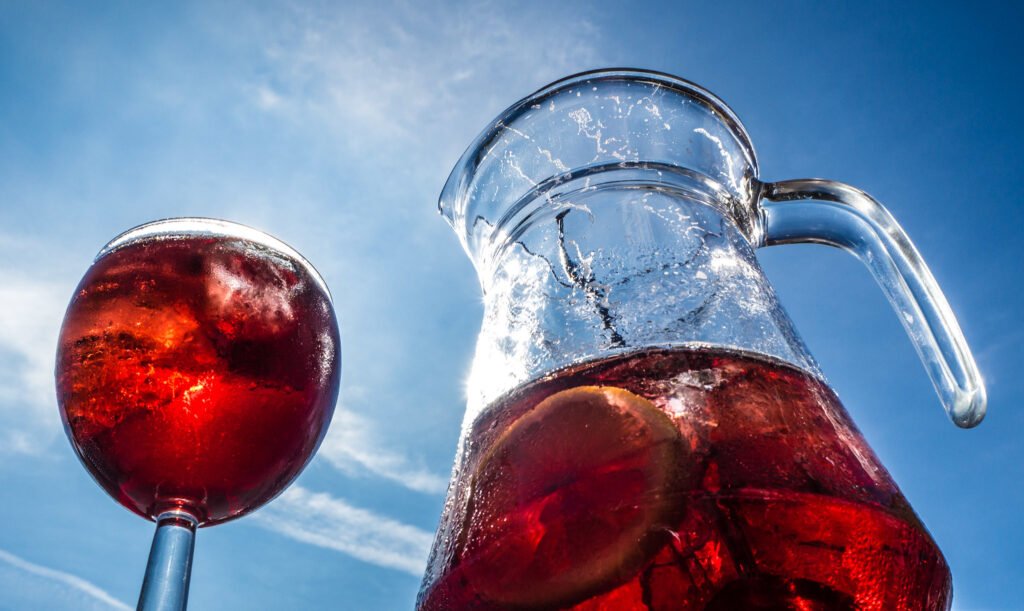
Clerico varieties to enjoy in Buenos Aires
1. Traditional Clericó
- Wine: Usually made with a dry white wine or sometimes a light red wine.
- Fruits: Apples, oranges, and peaches are the staples, providing a perfect balance of sweetness and acidity.
- Additional Touch: A splash of soda or sparkling water to add lightness, and a few tablespoons of sugar or honey to sweeten, if desired.
2. Tropical Clericó
- Wine: A sweet white wine, like a Moscato, to complement the tropical flavors.
- Fruits: Mango, pineapple, kiwi, and banana make this version stand out for its exotic and rich fruit profile.
- Additional Touch: A bit of coconut water or a splash of orange juice can enhance the tropical vibe.
3. Berry Clericó
- Wine: Rosé wine is preferred for its fruity and floral notes that pair well with berries.
- Fruits: Strawberries, raspberries, blueberries, and blackberries offer a deep, sweet, and slightly tart flavor combination.
- Additional Touch: A splash of cassis or berry-flavored liqueur to intensify the berry flavors.
4. Citrus Clericó
- Wine: A crisp Sauvignon Blanc or another citrus-forward white wine.
- Fruits: A mix of lemon, lime, orange, and grapefruit segments or slices, providing a refreshing and zesty taste.
- Additional Touch: A splash of lemonade or limeade to enhance the citrus notes, with a hint of mint for freshness.
5. Red Wine Clericó
- Wine: A light and fruity red wine, such as a young Malbec or Beaujolais.
- Fruits: Pears, apples, and red grapes complement the depth of the red wine.
- Additional Touch: A splash of brandy or orange liqueur for added complexity, and a cinnamon stick for a hint of spice.
10. Soda in siphon
A staple in Buenos Aires’ culinary scene, soda en siphon (siphon soda water) is a throwback to a time when soda water was delivered to homes and businesses in distinctive siphon bottles. Today, this effervescent water remains a favorite for its refreshing taste and its role in classic Argentine cocktails and mixed drinks.
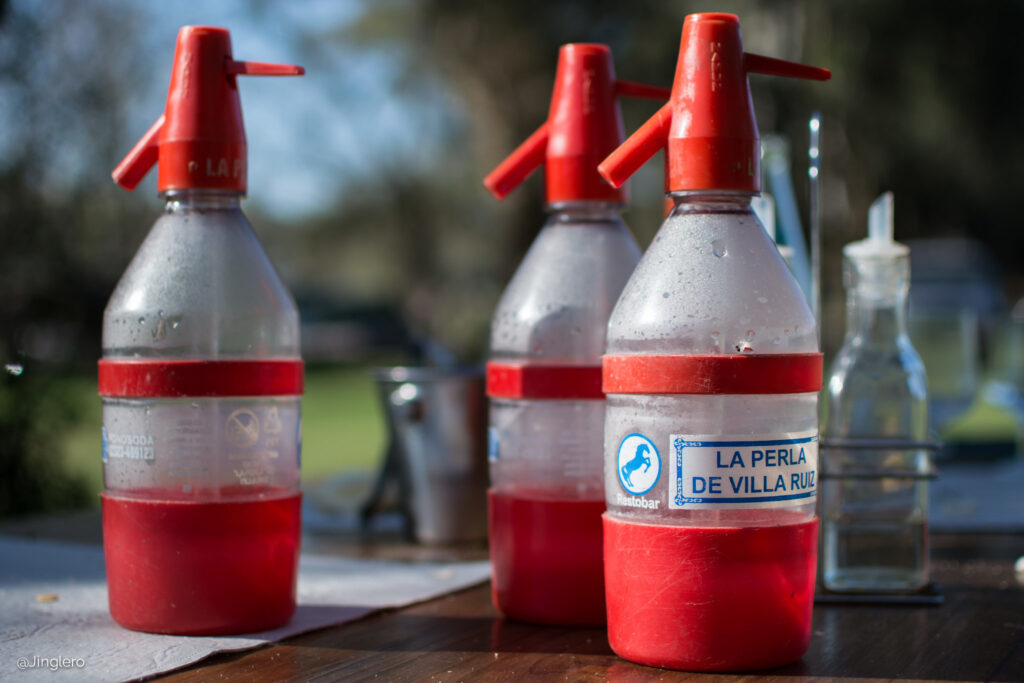
Many cafés and pizzerias in Buenos Aires still serve soda en siphon, offering a nostalgic nod to the past. Its crisp, clean taste makes it an ideal palate cleanser or a mixer for drinks, embodying the simple pleasures of Buenos Aires’ dining culture.
(Featured Image Source: marquezmechi/flickr.com)


